
We have a real treat for you this month – an issue dedicated to the Cromwells! And it’s a great one with 82 pages packed full of Tudor goodness.
[Read More...]
We have a real treat for you this month – an issue dedicated to the Cromwells! And it’s a great one with 82 pages packed full of Tudor goodness.
[Read More...]
On this day in Tudor history, 30th June 1559, keen sportsman, King Henry II of France, suffered a mortal head wound while jousting. He died on 10th July and was succeeded by his son, Francis II.
Jousting was a dangerous sport and Henry was fatally injured when splinters from his opponent’s lance entered his right eye. Awful!
Find out more about Henry II’s accident and death, and also his reign, in today’s talk.
[Read More...]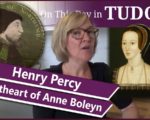
On this day in Tudor history, 29th June 1537, just over a year after the execution of his former sweetheart, Anne Boleyn, Henry Algernon Percy, 6th Earl of Northumberland, died at around the age of thirty-five.
He’d been ill for some time and had actually collapsed after he sat in judgement on Anne Boleyn and her brother, George, in May 1536. But who was Henry Percy and what happened between him and Anne?
Find out more about him in today’s talk.
[Read More...]
On this day in Tudor history, 28th June 1557, Philip Howard, 13th Earl of Arundel, was born at Arundel House, the Strand, London.
Philip ended up being condemned to death for treason and dying of alleged poisoning in 1589, when he was just 32, so let me tell you a bit more about him and what led him to that very sticky end.
[Read More...]
The Tudors were just as keen on giving people nicknames as we are today, particularly Elizabeth I, but how much do you know about the nicknames of prominent Tudors?
Test your knowledge with this fun little wordsearch. Be warned: the words can go in any direction!
Good luck!
[Read More...]
On this day in Tudor history, 27th June 1497, in the reign of King Henry VII, lawyer and member of Parliament Thomas Flamank and blacksmith Michael Joseph (known as Michael an Gof), two of the chief commanders of the Cornish rebels, were hanged, drawn and quartered at Tyburn in London.
What had led them to this awful end? What was the Cornish Rebellion about and why do they have “fame permanent and immortal”? Find out more about them and their ends in today’s talk.
[Read More...]
On this day in Tudor history, 26th June 1596, soldier Sir John Wingfield was buried in the cathedral at Cadiz in southern Spain. Wingfield had been shot in the head in the attack on Cadiz on 21st June.
John Stow recorded that at his funeral “the generalls threw their handkerchiefs wet from their eyes into the grave” and poet John Donne wrote “Farther than Wingfield, no man dares to go”, but who was this courageous soldier?
Find out more about him and how he died in today’s talk.
[Read More...]
A recent forest fire here in Spain got me thinking about fires in medieval and Tudor times – how essential fires were, how they were lit, how they were controlled and prevented from getting out of hand, and what happened when homes and buildings did catch fire. We’ve all heard about the Great Fire of London in 1666, but what about the 1212 Great Fire or the 1583 Great Fire of Nantwich?
Find out all about medieval and Tudor fires in this week’s Claire Chats talk:
[Read More...]
On this day in Tudor history, 25th June 1503, the nearly twelve-year-old Henry, Prince of Wales, eldest surviving son of King Henry VII, got betrothed to seventeen-year-old Catherine of Aragon at the Bishop of Salisbury’s palace in Fleet Street, London.
But why did it take them until 1509 to get married? What happened?
Find out about their betrothal and their subsequent break-up in today’s talk.
[Read More...]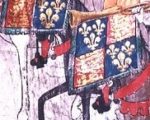
John Blanke was a royal trumpeter and was employed as a musician at the court of Henry VII and Henry VIII, his first appearance at court being recorded in 1507. It is believed that John Blanke was of African descent; however, sadly, his age, date of birth, parentage, and place of birth all remain unknown to us.
It appears that John Blanke was part of a larger trend in Europe at the time in which rulers tended to employ African musicians. It is believed that this happened from as early as 1194 when it is documented that turbaned black trumpeters were involved in the procession of Henry VI, Holy Roman Emperor, into Palermo in Sicily. Scholars have suggested that Blanke arrived in England alongside Katherine of Aragon as part of her retinue when she came to marry Prince Arthur in 1501. Although we have evidence for an African presence in her retinue, there is no record of John Blanke being a member, so this is speculative. Also, given the fact that the Tudor court employed musicians from all over Europe, Blanke could have come from Spain, Portugal, or Italy, as these countries had an increasingly large African population.
[Read More...]
On this day in Tudor history, 24th June 1532, the feast of St John the Baptist, Robert Dudley, Earl of Leicester and favourite of Elizabeth I, was born.
Elizabeth I called Leicester her “eyes” and “sweet Robin” and there was gossip over their relationship, but there was far more to Robert Dudley than his closeness to the queen. Find out all about his life and career in today’s talk:
[Read More...]
On this day in Tudor history, 23rd June 1576, painter and miniaturist, Levina Teerlinc, died at Stepney in London.
Teerlinc was court painter to Henry VIII, Edward VI, Mary I and Elizabeth I, and was a prolific artist. Find out more about Levina Teerlinc and her work in today’s talk.
[Read More...]
On this day in Tudor history, the night of 22nd June 1509, King Henry VIII rewarded twenty-six men for their loyal service to the crown by making them Knights of the Bath as part of the celebrations for his coronation.
One of the men honoured for his service to the crown was Thomas Boleyn, father of the future queen, Anne Boleyn. But what had he done to deserve this honour? Find out more about Thomas Boleyn’s rise at the court of Henry VII, and how he was a royal favourite long before his daughters became involved with the king, in today’s talk.
[Read More...]
On this day in Tudor history, 21st June 1553, letters patent were issued stating that the dying King Edward VI’s heir was Lady Jane Grey, eldest daughter of the king’s cousin, Frances Grey (née Brandon), Duchess of Suffolk.
Why was Lady Jane Grey his heir when Edward had two half-sisters, Mary and Elizabeth, and who else was listed in his “devise for the succession”. Find out more about Edward VI’s plan for the succession in today’s talk
[Read More...]
Today is Father’s Day in several countries so I thought I’d made Tudor fathers the theme of our Sunday quiz this week.
It’s a true or false quiz, so at least you have a 50% chance of getting each question right! Good luck!
[Read More...]
On this day in Tudor history, 20th June 1540, Henry VIII’s fourth wife, Queen Anne of Cleves, complained to her advisor about her husband’s interest in one of her maids of honour, a certain Catherine Howard. What was going on and what happened next?
Find out more about the final weeks of Henry VIII’s and Anne of Cleves’ marriage in today’s talk.
[Read More...]
On this day in Tudor history, 19th June 1573, Jesuit priest and former rector of a Lincolnshire parish, Thomas Woodhouse, was hanged, drawn and quartered at Tyburn.
Blessed Thomas Woodhouse was the first priest to be executed in Elizabeth I’s reign, and he was beatified in December 1886 by Pope Leo XIII.
When you hear what he said to William Cecil, Lord Burghley, you can understand just why he was seen as a traitor by Burghley and Elizabeth I’s government. Not wise words in those times, but he stuck to his faith and principles.
Find out more in today’s video.
[Read More...]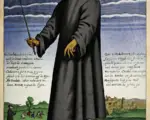
This week’s Claire Chats talk has been inspired by the precautions that many of us are taking at the moment to protect ourselves against Covid-19, coronavirus.
We’re using social distancing, quarantine and face masks, but how did medieval and Tudor people try and protect themselves from illnesses like the plague and sweating sickness? Find out in this today’s Claire Chats talk:
[Read More...]
Yes, you read that title right! On this day in Tudor history, 18th June 1558, the will of Welsh mathematician, physician and mint administrator Robert Recorde was proved.
Recorde invented the “=” sign and wrote books on mathematics and also a urological treatise “The Urinal of Physick”.
Let me tell you all about this man and his works, which have such catchy titles!
[Read More...]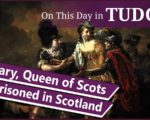
On this day in Tudor history, 17th June 1567, Mary, Queen of Scots, was imprisoned at Loch Leven Castle following her surrender at the Battle of Carberry Hill on 15th June.
Sadly, while she was imprisoned there, she miscarried twins and was forced to abdicate. She eventually escaped, but her freedom was only temporary.
Find out more about this time in Mary, Queen of Scots’ life in today’s talk.
[Read More...]
On this day in Tudor history, 16th June 1514, English classical scholar and statesman, Sir John Cheke was born in Cambridge.
Cheke was the first Regius Professor of Greek at Cambridge University, tutored King Edward VI, served as Secretary of State to Queen Jane (Lady Jane Grey) and was imprisoned by Mary I for his reformed faith. He died a broken man after denying his faith to survive. Find out more about him in today’s talk.
[Read More...]
On this day in Tudor history, 15th June 1559, William Somer (Sommers), court fool to Henry VIII, Edward VI and Mary I, died in Shoreditch, London.
Somer managed to survive upsetting the king by calling Anne Boleyn and Elizabeth names, although the king apparently was so furious he wanted to kill him, and he died a natural death in Elizabeth I’s reign.
Somer wasn’t the only court fool at the time, Jane the Fool served Anne Boleyn, Catherine Parr and Mary I. Find out about Will Somer and Jane the Fool, the Tudor Court Fools, in today’s talk.
[Read More...]
On this day in Tudor history, 14th June 1536, not long after the fall of Anne Boleyn, two courtiers, Sir Anthony Browne and Sir Francis Bryan, were interrogated regarding their alleged support of Mary, daughter of King Henry VIII by Catherine of Aragon.
Both men had been involved with the Catholic conservatives and Seymours who had worked to bring Anne Boleyn down and who wanted Mary restored to the succession, but now they found themselves in a spot of trouble.
What happened and how did Bryan and Browne get out of trouble?
Find out more in today’s talk.
[Read More...]
Today’s Sunday puzzle will be nice and easy for you if you’ve been watching my “on this day in Tudor history” videos or reading the transcripts. How much can you remember about events that happened between 1st and 14th June in the Tudor period? Test yourself with this fun crossword puzzle.
[Read More...]
On this day in Tudor history, 13th June 1548, Thomas Seymour, 1st Baron Seymour of Sudeley, and his wife, Catherine Parr, the dowager queen, set off from Catherine’s manor of Hanworth in London to travel to Seymour’s seat of Sudeley Castle. They were accompanied by Lady Jane Grey and around 100 others.
Seymour wanted his wife to enjoy the final months of her pregnancy safe in the Cotswolds away from the Plague in London and for his first-born child to be born at Sudeley.
In today’s talk, I share details on who accompanied the couple, what Sudeley was like and what happened next.
[Read More...]
On this day in Tudor history, 12th June 1540, a clearly frightened Thomas Cromwell, who was imprisoned in the Tower of London following his arrest on 10th June for treason, wrote to King Henry VIII regarding his “most miserable state”, asking for mercy, and pleading his innocence.
I share Cromwell’s letter in today’s talk. It is an eloquent letter but also a very moving one. His fear is palpable.
[Read More...]
As well as Tudor history and all things Harry Potter, I love wildlife. When we first moved to Spain, I loved discovering the new creatures on my doorstep – from colourful new bugs in the garden and geckos in the house, to mountain goats on cliff faces at the side of roads and snakes crossing in front of us. Brilliant!
The sounds of wildlife during lockdown inspired me to do this Claire Chats talk on the animals that could be found in Britain in the medieval and Tudor periods…
[Read More...]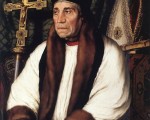
William Warham was born in Church Oakley in Hampshire to parents Robert and Elizabeth. His origins were humble, evidenced by a commemorative brass in Church Oakley presumably set up by William himself, the brass carrying with it no emblems of social distinction. His uncle was also a carpenter, which further hints at his humble upbringing. William was educated at Winchester College and New College, Oxford, becoming a fellow in 1475 and acquiring a doctorate in canon law.
In 1448, Warham moved to London to take up a post in the Court of Arches, and two years later, it is believed he went to Rome as a proctor of John Alcock, Bishop of Ely. Soon after, he began to procure sinecures, including the archdeaconry of Huntingdon and the precentorship of Wells. In 1491, Warham performed his first secular duty when he was appointed to the English party sent to Antwerp to discuss disputes with merchants. In 1493, he travelled to Burgundy to meet with Margaret, Duchess of Burgundy, to attempt to halt support for Perkin Warbeck, a pretender to the English throne. In February 1494, he received his long-awaited royal preferment to the mastership of the rolls. This position granted him numerous opportunities as be began to negotiate the marriage of Prince Arthur and Katherine of Aragon with the Spanish ambassador. In 1501, his negotiations with Emperor Maximilian I ensured that he was able to hand over a major threat to the reign of Henry VII – Edmund de la Pole.
[Read More...]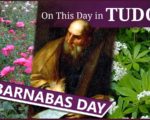
Happy St Barnabas Day!
Yes, 11th June is the Feast of St Barnabas, a feast day that was celebrated by the Tudors by decorating churches with garlands of flowers.
Find out more about St Barnabas and how he was commemorated in medieval and Tudor times in today’s talk.
[Read More...]
On this day in Tudor history, 10th June 1584, in the reign of Queen Elizabeth I, Francis, Duke of Anjou and Alençon, died in Paris. It is thought that he died of malaria.
Why am I talking about a French duke? Well, for a time, he was a suitor of Queen Elizabeth I and the queen even affectionately called him her “frog”. It looked like Elizabeth would actually marry him.
Find out more about what happened between Elizabeth and her dear “frog” in today’s talk.
[Read More...]